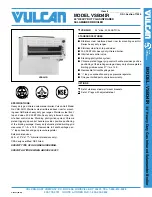
SUMMIT BOILER OR WATER HEATER
Page 27
resistance of a good sensor is 10,000 ohms
@ 77°F (25°C). Replace sensor if
resistance is less than 500 or more than
32,000 ohms.
F-5 Check to see that the internal pump is
operating. If it appears to be OK, check to
determine if the pump is air bound. Check
differential pressure switch.
8.5 Resolving Lockouts (LO)
Lockout will show as [LO] on the Summit
display. Lockout conditions are not associated with
fault conditions. Accessing the memory of past
faults will not help to troubleshoot lockout
conditions.
The memory does not need to be accessed.
Memory fault codes are for error history only. All
thermistor faults will show as “F” codes on the
LED, and will never cause the LED to read “LO”.
There are many causes for lockouts. The four most
common causes are: (1) poor flame sensor signal, (2)
inadequate gas supply, (3) poor combustion,
(4) ignitor failure.
1.
Poor flame sensor signal: The burner control,
PCB, will lockout if the flame sensor is
grounded or if the flame signal it receives is less
than 1 mA dc. To check for a grounded sensor,
remove the flame sensor wire (yellow) from the
PCB and, using a meter set for at least 100,000
ohms (
W
), check the resistance between the
yellow wire terminal and the combustion
chamber bottom pan. The resistance must be
more than 250,000
W
. If it is less, debris or
moisture in the combustion chamber may be the
cause. To correct, carefully remove the ignitor/
flame sensor assembly. Look for debris on the
assembly where the flame rod exits the ceramic
tube. If debris exists, remove it. If this area is
clean, insert a pencil or other round object into
the flame sensor hole in the top combustion
chamber head and roll it around to clear any
debris that may exist inside the combustion
chamber. Replace the ignitor/flame sensor
assembly, reconnect the yellow wire on the PCB
and start the boiler. If lockout persists, check the
flame signal. To check the flame signal,
disconnect the yellow wire from the flame
sensor, connect a meter, set for microamps (mA)
DC, between the flame sensor connector and the
yellow wire connector. Start the boiler. If the
meter reading is less than 1.00 mA DC, (see 3.
below) “poor combustion”.
2.
Inadequate gas supply: Before proceeding,
ensure that the gas supply has not been shutoff
or the LP tank (LP boilers) is not empty. Then,
reset the boiler and observe the operational
cycle. Approximately 20 seconds after the start
of the cycle, the GV LED on the PCB should
light. If it does not, reset the boiler and check for
24 VAC at the plug on the PCB. If the voltage is
less than 20 VAC, and transformer voltage is 24
VAC replace the PCB. If the voltage is correct,
connect a pressure gauge to the offset pressure
port on the gas valve. Reset the boiler and
observe the offset pressure at startup and after 20
seconds. The pressure will be ~ -2 in. w.c. at
startup (during prepurge) and should become
less negative (-0.01 in. w.c.) when the gas valve
opens and gas flow starts. If the pressure remains
at ~ -2 in. w.c. Throughout the cycle replace the
gas valve.
3.
Poor Combustion: Poor combustion should be
suspected if there is a strong flue gas odor. The
odor may result from an improper gas/air ratio
(high or low O
2
or CO
2
). If an improper gas/air
ratio is suspected refer to Section 7.2.2.1.
4.
Ignitor failure: If the boiler goes through a
normal start cycle but combustion does not
occur, ignitor failure should be suspected.
Check the ignitor by unplugging the ignitor plug
and measuring the ignitor resistance. It should be
50-80 (
W
) Ohms. If the resistance is not 50-80
ohms (
W
), replace the ignitor. If the resistance is
correct, reset the boiler and check for 120 VAC
at the ignitor plug during the start cycle. If there
is no voltage, replace the PCB or faulty ignitor
wires.
8.6. Delayed Ignition - Possible Causes
8.6.1 High Lockup Pressure
(LP appliances) - occurs on start-up
High lock up pressure is the most common cause
of delayed ignitions on LP fueled appliances. It may
result from an improper second stage regulator
selection or from a faulty regulator.
Lock up can be detected by measuring the gas
supply pressure to the appliance at the inlet pressure
port on the gas valve. The gas supply to the appliance
must be shut off before making any connections. To
check: use a water manometer or pressure gauge with
a scale reading of at least 25 in. w. c. or 15 oz/in
2
.
Loosen the screw in the gas valve inlet pressure port
one full turn and push the hose from the pressure gage
over the pressure port. Turn on the gas supply. The
SUMMIT appliance is designed to operate with
supply pressures of 4-13 in. w. c. (2.3 - 7.5 oz/ in²). If
the supply pressure exceeds 13 in. w. c. (7.5 oz/ in²)
(with the appliance off) it is possible that this may be
the cause of the delayed ignitions and the inlet
pressure must be reset to ~ 9 in. w. c. (5.2 oz/ in
2
).
Restart the appliance and then switch it off. If the inlet
gas pressure exceeds 13 in. w. c. (7.5 oz/ in²) after the
appliance is switched off, correct the lock up problem.
Summary of Contents for SMB-200
Page 28: ...Page 28 LAARS HEATING SYSTEMS POWER UP FAULT TREE ...
Page 29: ...SUMMIT BOILER OR WATER HEATER Page 29 SYSTEM TEMPERATURES FAULT TREE ...
Page 31: ...SUMMIT BOILER OR WATER HEATER Page 31 IGNITION FAULT TREE ...
Page 33: ...SUMMIT BOILER OR WATER HEATER Page 33 Figure 21 Parts Identification ...
Page 34: ...Page 34 LAARS HEATING SYSTEMS ...










































